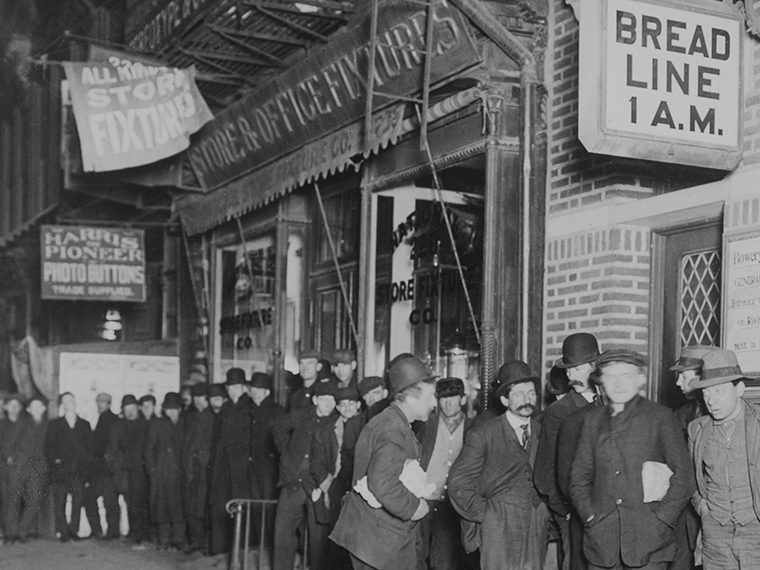Banks close neighborhood outlets and raise prices for branch-delivered services
Mobile banking has been heralded as a prime example of how the advent of fintech would benefit consumers. That’s how it has typically played out in developing nations, as the ability to bank on a smartphone has been a game changer where a dearth of physical branches, and the difficulty of accessing those that did exist, kept banking out of reach for hundreds of millions of people.
A working paper shows a messier story in the United States.
USC’s Erica Xuewei Jiang, Singapore Management University’s Gloria Yang Yu and UCLA Anderson’s Jinyuan Zhang show that uneven adoption of mobile banking across demographic groups triggers operational shifts by banks that can disadvantage older and lower-income consumers.
Opt In to the Review Monthly Email Update.
Competition, or Lack Thereof, Is Key
Leveraging data that tracked the rollout of 3G cellular technology, the researchers studied the relationship between mobile banking uptake and the availability of bricks-and-mortar branches. They found that in counties dense with mobile adopters (younger, higher income), banks reduced the number of physical branches. In counties where mobile banking is less popular (older, lower income), banks stuck more with the branch model, and notably benefited from less competition for that customer as the overall number of branches in a region fell.
That varied banking response seems to create winners and losers among consumers. The researchers found that banks that are less reliant on branches offer consumers better deals. They pay slightly higher deposit rates relative to banks that are more reliant on branches.
Competition is one driver of this dichotomy. Jiang, Yu and Zhang provide empirical evidence that banks embracing mobile banking enter new markets; without the need for physical branches (or only needing a limited number of branches), expansion is less expensive. Overall, the rise in banks competing for mobile customers after the availability of 3G increases competition at the county level.
And when you’re competing for mobile customers, you seem to be willing and able to pass along some of your savings from not carrying the costly weight of maintaining so many branches. On the flip side, the overall decline in branches reduces access and increases hassle for those who prefer in-person banking. And banks that hold fast to the branch model face less competition, which allows them to raise their prices on consumer products.
Moreover, this research finds that this form of fintech does not uniformly solve the problem of the nation’s unbanked and underbanked. While the number of unbanked households continues to decline — it is now under 5% and underbanked is more than 15% — the researchers found a similar age-based pattern in how the availability of high-speed mobile banking impacted this cohort.
After the introduction of 3G, the ranks of the unbanked or underbanked younger than 45 declined 24.9%, while the unbanked/underbanked at least 45 years old increased 12.6%. The divergence was even more pronounced when focusing on lower-income unbanked. Among households with income below $30,000, the percentage of unbanked/underbanked decreased nearly 45% among younger households, and increased more than 31% among older households.
“While tech-savvy consumers benefit from intensified bank competition, nontech savvy consumers suffer from the reduced number of branches and pay higher costs to access banking services,” the authors write. “This distributional effect echoes policymakers’ rising concern about digital inequality.”
How 3G Changed Banking
The rollout of the 3G cellular network in the U.S. gave Jiang, Yu and Zhang a unique opportunity to measure how mobile banking impacted the availability and usage of bricks-and-mortar branches. The arrival of 3G technology gave banks the speed, capacity and security necessary to deliver the mobile banking services we now take for granted. Given that the rollout was not uniform across the U.S., the researchers were able to explore the relationship between the availability of 3G networks between 2007 and 2019 on consumer uptake, bank management decisions (expanding into new markets via mobile access, closing down branches) and the trickle-down impact on consumer access and cost.
Information on bank branches and consumer preference for mobile banking from the Federal Deposit Insurance Corp. was analyzed through the lens of metropolitan statistical area data on when 3G became available. That enabled the researchers to sort banks by their relative reliance on the traditional branch model as mobile banking became a robust option. They then layered in branch-level data sources for deposit rates and loan costs to assess if the evolution of mobile banking acceptance impacted consumer experience.
As the graphics below show, consumer uptake of mobile banking is highly skewed by age and income.
The researchers found that after 3G was widely available, the overall number of branches declined by 1.4% overall. But there were twice as many closures in counties with a higher proportion of younger people (under 55) compared with counties with a higher proportion of older people. If you happen to be an older resident in a younger county, that effectively means you have fewer bank branches to visit, which can become a meaningful hassle. Additional analysis by the researchers found that the preferences of the younger mobile-inclined was a driver of bank decisions to close branches. Higher-income counties also experienced relatively more branch closures.
To further explore the impact of 3G on branch strategy and consumer deposit and loan rates, Jiang, Yu and Zhang created a measure of each bank’s reliance on branches in 2007 (pre-3G). They calculated the number of branches required to service every $1 million of deposit. They deemed the bottom quartile to be “less reliant” on branches and the top quartile to be “more reliant.”
The less-reliant group reduced their branch networks by 4% after the arrival of 3G technology and were 2.4% more likely to close down all branches. The quartile more reliant on branches held on to more branches.
Branch Reliance Impacts Consumer Experience
The researchers calculate that after the arrival of 3G, banks with a low reliance on branches demanded a smaller spread between the federal funds rate and the rate they paid on savings deposits. The 1.9 basis point spread reduction effectively increased consumer deposit rates. The banks with a high reliance on branches increased their spread by 1.6 basis points, as they had a more captive audience among analog customers confronted with fewer branch options and, thus, felt no compunction to compete hard on deposit rates.
The same trend showed up in mortgage lending. Lenders with a low reliance on physical branches lowered their spread by 7.3 basis points once 3G became ubiquitous in a county, whereas lenders with a higher dependence on costly bricks-and-mortar increased their spread, effectively delivering costlier loans to customers. That trend held up when the team analyzed auto loans and unsecured credit loans.
Given the cost and access disadvantage for those resistant to embracing mobile banking, the researchers modeled out the potential impact of federal regulation of branch availability. They suggest that imposing stricter restrictions on branch closures is a net win. The additional cost of maintaining more branches disadvantages the younger/higher income cohorts who embrace mobile technology. But that is outweighed by “old consumers, especially old depositors, (who) benefit from the regulation.”
That said, as the baby boom generation gives way to digital-native generations in coming decades, the current inequities wrought by the mobile banking revolution may dissipate.
Featured Faculty
-
Jinyuan Zhang
Assistant Professor of Finance
About the Research
Jiang, E.X. and Yu, G. Y. and Zhang, J. (2022). Bank Competition amid Digital Disruption: Implications for Financial Inclusion.






